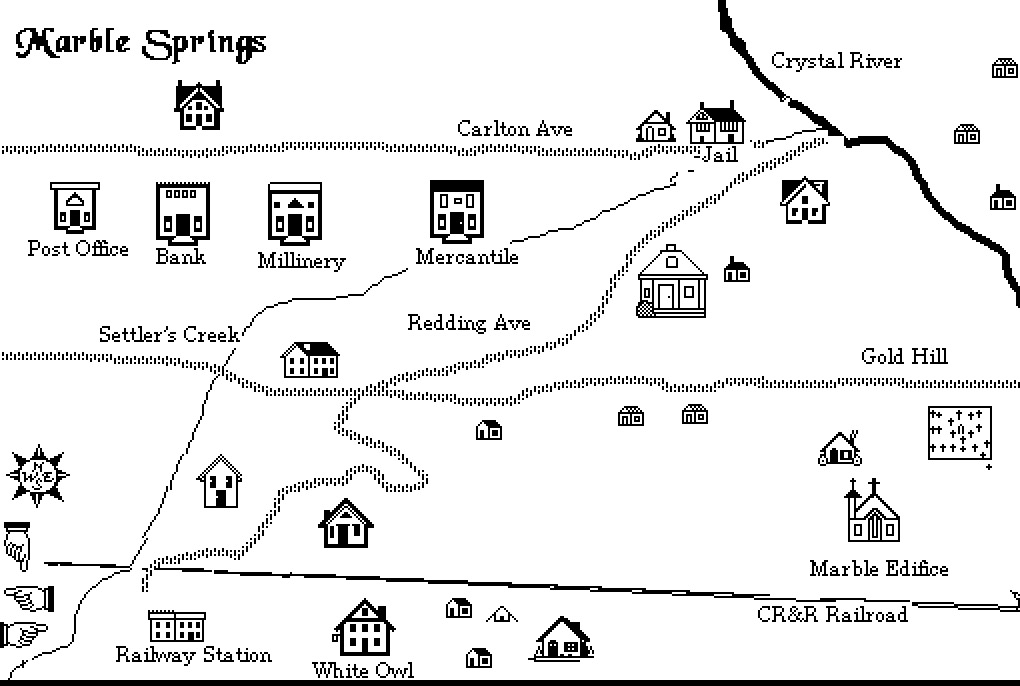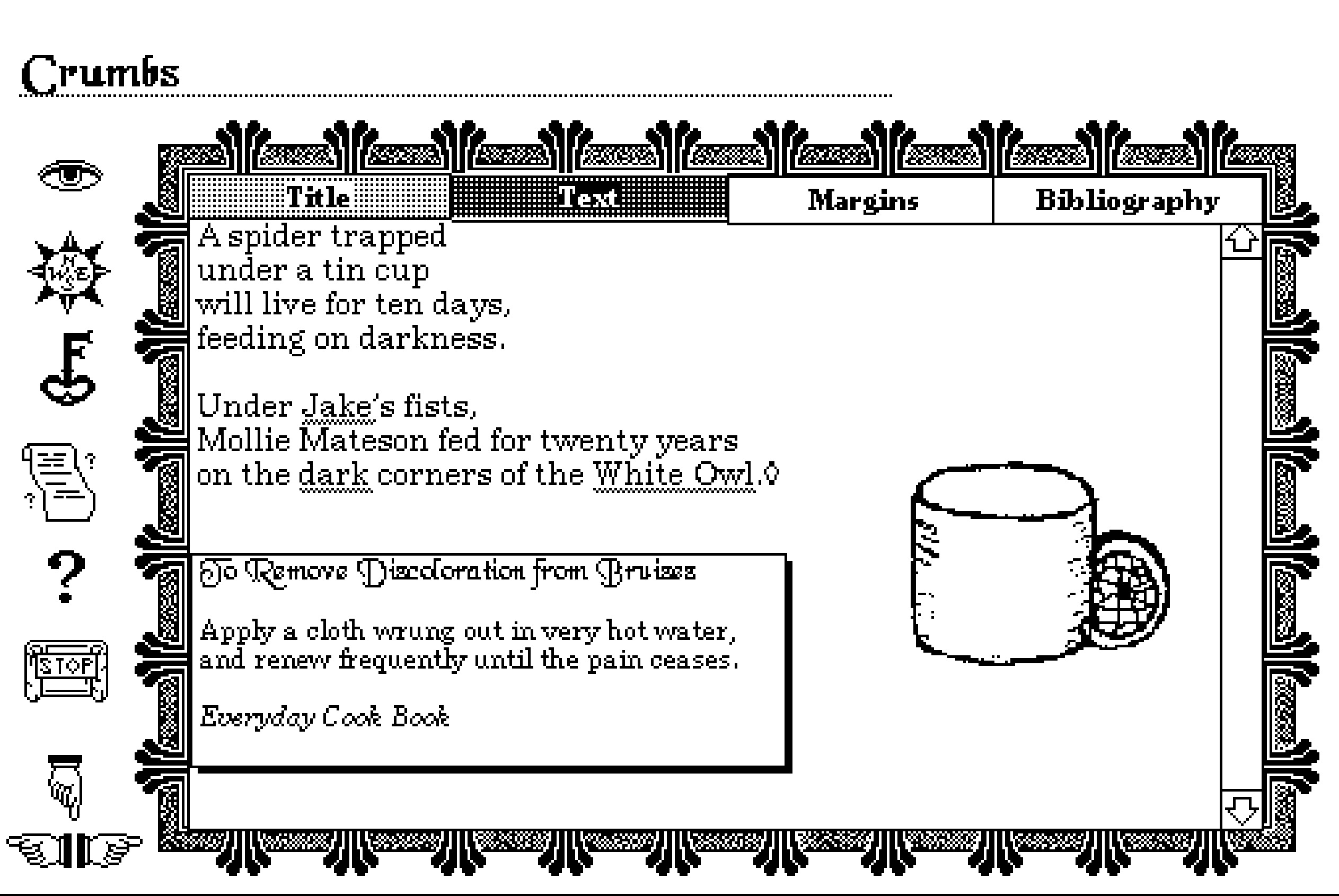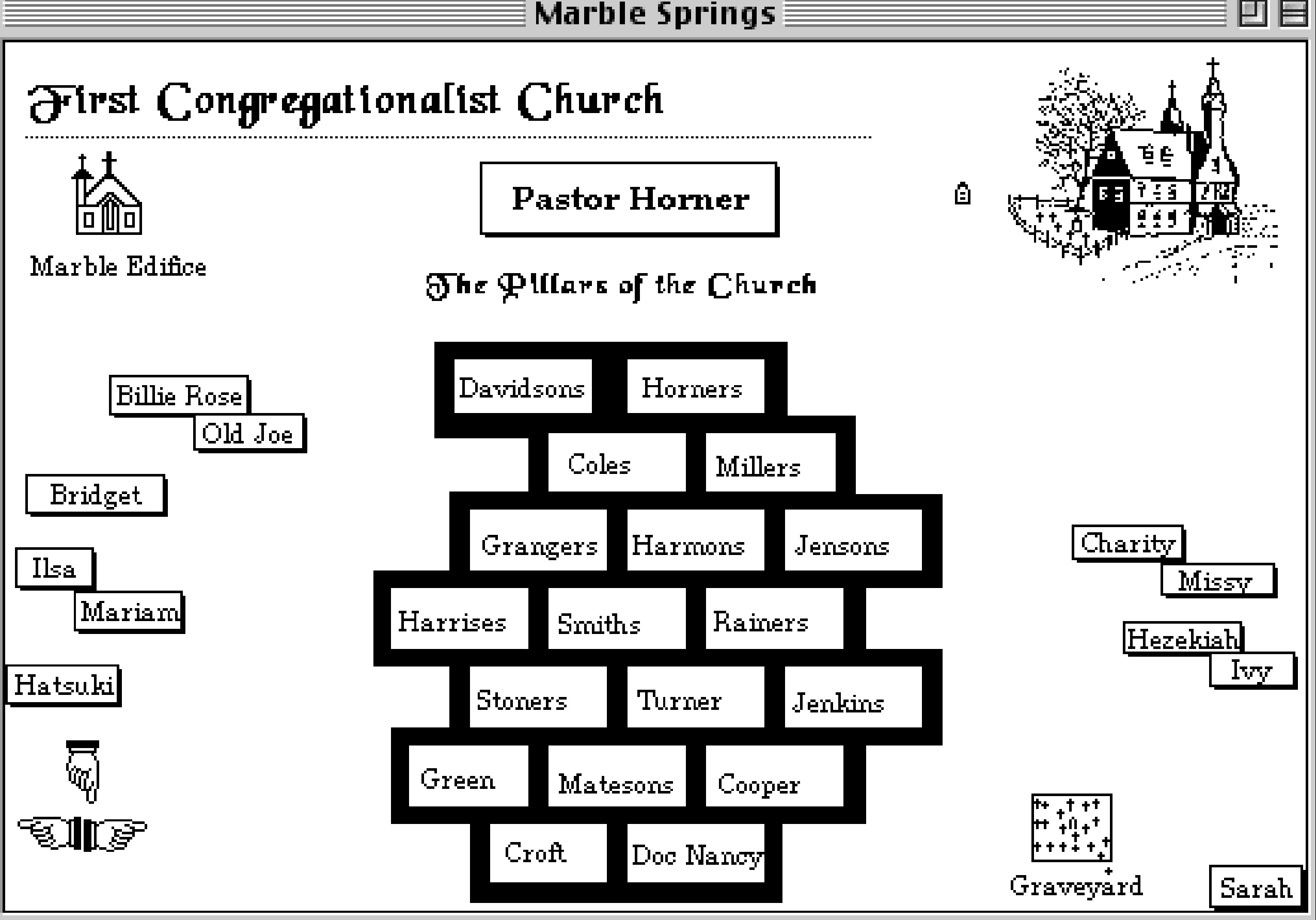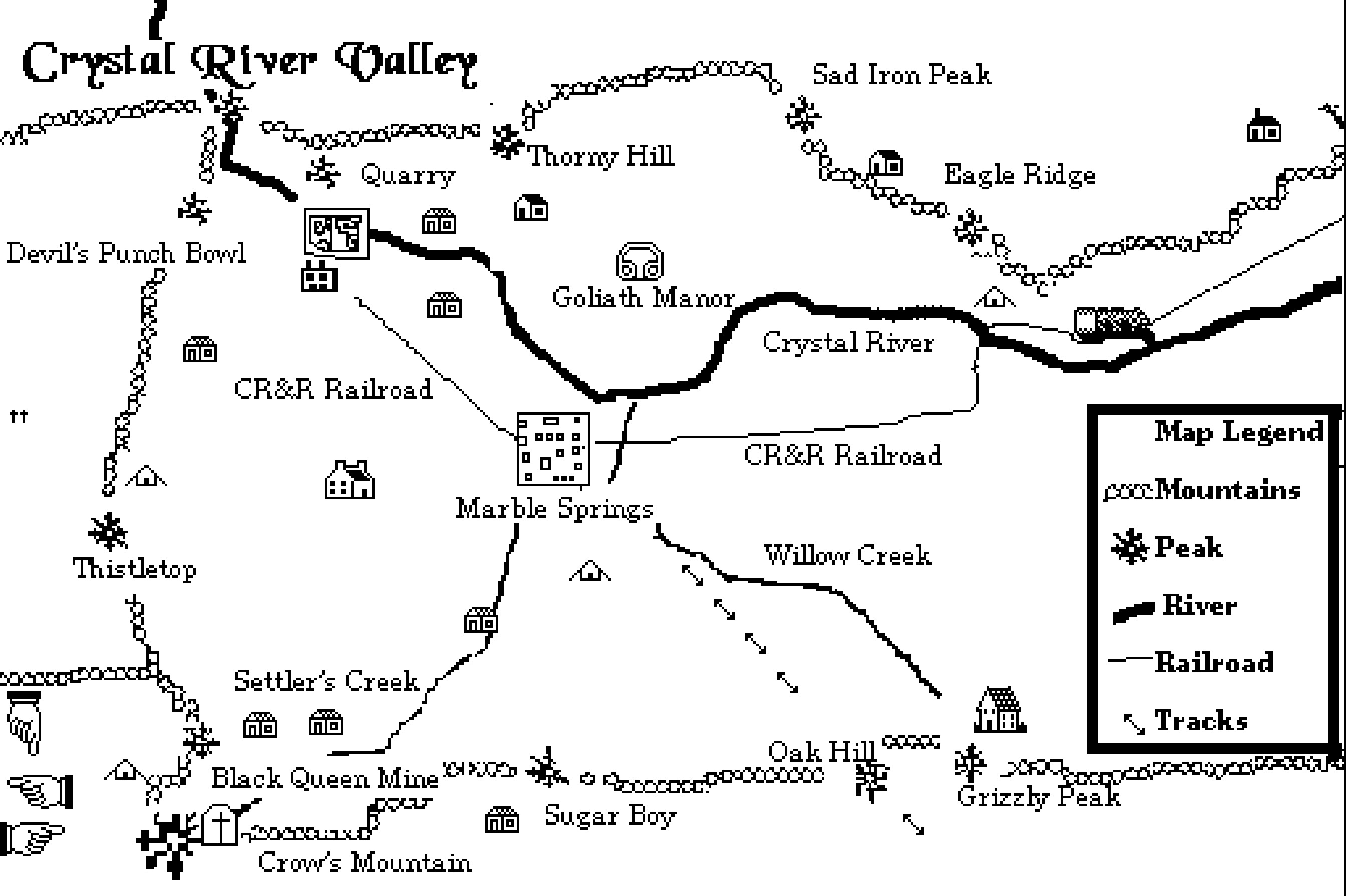The Hill, an introductory poem of the Spoon River Anthology by Edgar Lee Masters, is an epic style invocation with a series of repeated questions about the whereabouts of dead citizens of the town, each called by name, and a refrain “all are sleeping on the hill”. Because the fate of the deceased is just shortly mentioned, reading the poem today makes us want to activate the cross-referrals: each name begs to be converted to a link and take us to a more detailed story of its bearers life and death.
This is what Deena Larsen wanted to do with Lee Masters’ poems since her childhood and what she implemented in Marble Springs a collection of hypertext narrative poems published in 1993. Released on Hypercard by Eastgate Systems and read on 8 inch screens of Macintosh Classic II, Marble Springs converts Edgar Lee Masters’s formula into an engaging matrix of stories about the small mining town in Colorado. Each poem in the collection recreates key events from a live of a single character, mostly a woman, and includes several links to her family members, neighbours, institutions she affiliates with or “moods” which connect her to other characters.
[1] This is the fourth in series of notes about works of the early e-lit which are the main focus of the forthcoming Rebooting Electronic Literature vol. 4, made by the team at the Electronic Literature Lab, Washington State University Vancouver.
The overarching narrative is framed in a fashion of the classical "story within the story" structure: a heap of notes and writings about the denizens of Marble Springs is found in the tree trunk by the church. The reader, presented with Hypercard stacks which organize the notes into characters' profiles, main text, margins and bibliography related to their stories, is given a task of exploration and discovery. And there is a lot to explore: stories of profiles of at least 56 women, 35 men, and 16 locations and institutions are included in Marble Springs. There are several interface layers, clickable maps, and character connections’ diagrams. Readers are encouraged to return to the maps of the valley, the town, and graveyard, as well as to the index of names and places. This way the shared histories of women of the American West are being connected not only by following implicit links, but also by uncovering “secret areas”, additional pop-up windows, details of illustrations, additional patterns in graphical layout (even the thickness of lines connecting persons of places represents some important aspects of their lives). An element of programmed randomness is also at play: clicking on the same graphic or even an empty space on the map can take readers in different directions on their second reading.
Lee Masters’ narrative idea of “democracy in death” where every inhabitant of the graveyard from the Spoon River Anthology tells their own story in their own voice in Marble Springs gives way to a decidedly woman’s perspective. This is a hypertextual western, but instead of brief glimpses of women behind the scenes, it delivers a full female voicing of the experience of American West, the world of domestic abuse, abortions, prostitution, where women are gambled in card games or gang raped. At the same time Marble Springs demonstrates how progress and hope in communities was spurred and cultivated by women’s solidarity and self-organising skills (represented by Ladies Aid Sewing Circle and Rescue Society). Larsen’s work is another great example demonstrating how electronic literature, from its early stages, was able to accumulate feminist discourse and storytelling by women and about woman.
On the level of interaction, Marble Springs presents uniquely open and participatory structure. If one applies it to cybertext typology, the work will score high on textonic user activity. Readers can add their own poems, biographical data and even their own links to the original text. Although the full participation was not trivial and required full version of Hypercard 2.0, more than 20 submissions of reader produced content was sent to Eastgate Systems. Some of these stories were later included in an unpublished second Hypercard edition from 1998.
As a work which takes a full advantage of Hypercard, up to a point of overclocking the program’s internal mechanisms, Marble Springs subverts some key elements of the early hypertext theory and design, especially the notion of lexia as a discrete unit of information. A useful semantic widget of “hypertext statistics” typical for Storyspace and web based projects, is also not applicable to Larsen’s work. Instead of a networked graph of nodes and links, Marble Springs relies on the structure of nested cards.
[2] Some information about the work and its reception comes directly from the author.
The units of narrative meaning are nested in each other, overlayed on top of each other and heavily connected. Because a single hypercard stack contains several tabs of content, and because maps, diagrams and graphics activate sub-panels of text content with links, one is not really able to determine what counts as lexia. There are elements similar to text bubbles, but some of them also contain links; there are illustrations, and some of them with hidden links, others are segmented into smaller parts. The ontology of nested and networked digital objects is rich, diverse and transcends the simple node-link model. Deena Larsen demonstrates that the unit of poetic, narrative or networked meaning is something altogether different. It lies in between objects and should be considered a process. It comes to view every time when the reader makes a meaningful connection between characters, stories and events. This process, often compared to quilt making in Larsen’s other works, in not equal to a simple link traversal or click-and-display type of interface action. The tension between implicit and internal, visible and invisible, told and untold stories and connections makes Marble Springs not only a work of life for its author, but also a reading for years for its audience.
The different editions of Marble Springs deserve their own thorough research. The long history of its incarnations has a cruel and yet all too common start: Hypercard, the software used to create the work, was officially discontinued the year Marble Springs was published. In 1993 Apple has stopped supporting the much loved authorial software. The original release on a 3.5-inch floppy disk for Macintosh computers and its later re-release on CD-ROM constitute the 1.0 version of the work. There is also a colorful Web excerptpublished by Eastgate shortly after the original Hypercard edition. Two more editions followed. The “unpublished” Hypercard edition from 1998, identified as Marble Springs 2.0 was and an extended, updated and upscaled version which was later used in the digital preservation project by Leighton Christiansen in 2012 (The pres/urrection of Deena Larsen's "Marble Springs, Second Edition). Christiansen’s work served as a foundation for the authorial edition of Marble Springs 3.0 published on the wiki.dot platform also in 2012. The last one is the only edition available for contemporary audience.
The live traversal of Marble Springs 1.0, read and commented by Deena Larsen, will take place on Thursday 3rd of December and then later included in n the forthcoming volume of the Rebooting Electronic Literature series published by Electronic Literature Lab at Washington State University Vancouver. The reading will be hosted by Mariusz Pisarski, research affiliate at the lab, and Dene Grigar, director of the lab.




